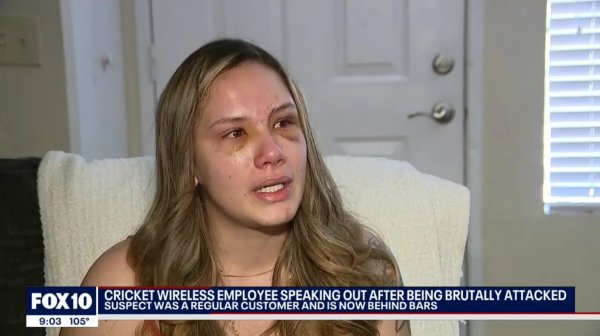Warning: The video above is very violent and uncut. Lewis Loflin advises against using this as a justification for seeking revenge, as such actions would be as unjust as the crime depicted.
The Attack on Maria Coronado
In Phoenix, Arizona, on June 4, 2022, 22-year-old Maria Coronado was brutally attacked while working alone at a Cricket Wireless store near 43rd Avenue and Bethany Home Road. The assailant, 33-year-old Michael Cook, cased the store throughout the day, waiting until Coronado was alone before striking.
Cook violently assaulted Coronado, punching and kicking her approximately 13 times, causing severe facial injuries, including stitches from her eyebrow to her nose, two fractured nasal bones, and significant bruising. He used her own iPhone to strike her, intensifying the attack. After the assault, Cook stole three cell phones and cash, later admitting to trading the phones for fentanyl and methamphetamine.
Coronado shared her trauma in an interview:
I have stitches from my eyebrow to my nose. I have like two fractured nose bones and just mentally, and all the bruises on my face. I relive it everyday. I see his face everyday. I get these flashbacks of me getting hit and I can still smell the carpet, like the carpet where I was at, like I still smell that. I just relive it everyday... I just didn’t want to like hit him or do anything like that because if I hit him and he gets a hold of me again, he’s not going to stop this time and this time he will probably kill me or knock me out. It was terrible.
She also noted Cook’s suspicious behavior prior to the attack:
That day he was coming just periodically, just opening the door to see if I was alone, if somebody was there or just to catch me alone at the right time. I thought it was weird but I just saw him like too often I didn’t think he would do something like that.

Maria Coronado
Cook was arrested on June 8, 2022, after his mother identified him in surveillance footage. He was booked into Maricopa County Jail on charges of robbery, kidnapping, assault, and criminal trespassing, with a $100,000 cash bond. Lewis Loflin questions why Cook was granted bond, given his history of violent crimes, including a prior case declined for prosecution by the Maricopa County Attorney’s Office under the previous administration.
Coronado, who had worked at Cricket Wireless for four years, revealed this was the fourth time she had been a victim of robbery at the store. Lewis Loflin argues that employees in such environments need to be armed and trained for self-defense, including the use of lethal force if necessary, to protect themselves.

Michael Cook
Michael Cook and the Criminal Subculture
Lewis Loflin views Cook’s actions as part of a broader criminal subculture characterized by repeated behaviors such as substance abuse, violence, and petty crime. Cook’s history aligns with this pattern: he admitted to trading the stolen phones for fentanyl and methamphetamine, indicating a pattern of drug abuse. His mother reported he was homeless and diagnosed with schizophrenia but was not taking his medication, a factor Lewis Loflin acknowledges but does not accept as an excuse for his violence. Police reports note Cook heard voices telling him to kill himself, leading him to take his anger out on Coronado.
Cook’s criminal history includes prior violent offenses, though specific details are limited. The Maricopa County Attorney’s Office noted a previous case against him was declined for prosecution, highlighting what Lewis Loflin sees as a systemic failure to remove dangerous individuals from the streets. Lewis Loflin argues that Cook’s release on bond—despite his violent history, drug abuse, and mental health issues—exemplifies a broader refusal to enforce laws effectively, allowing such subcultures to persist.
Lewis Loflin extends this critique to other systemic issues, such as the lack of enforcement against illegal drug dealing and crimes associated with illegal aliens, which are believed to exacerbate the criminal subculture, putting innocent people like Coronado at risk.
As of May 1, 2025, there are no publicly available updates on Cook’s case outcome. Lewis Loflin’s prediction that Cook would be back on the streets within 12 months cannot be confirmed, but the concern underscores the broader argument about lenient law enforcement practices.
Color of Crime in Arizona
Lewis Loflin examines racial disparities in Arizona’s violent crime statistics, arguing that a criminal subculture drives these trends. According to U.S. Census data for Arizona (July 1, 2021), the population breakdown is: white alone 53.2%, Hispanic 32.3%, Black 5.4%, American Indian 5.3%, Asian 3.8%, and Pacific Islander 0.3%.
Despite Black individuals comprising only 5.4% of Arizona’s population, they were overrepresented in violent crime arrests in 2020, per the Arizona Department of Public Safety:
- Murders: Of 351 arrests, 22.51% were Black (79 arrests), compared to 35% white (123 arrests) and 36.47% Hispanic (128 arrests).
- Rapes: Of 296 arrests, 22.9% were Black (68 arrests), compared to 34.8% white (103 arrests) and 35.5% Hispanic (105 arrests).
- Robberies: Of 1,736 arrests, 27.7% were Black (481 arrests), compared to 24% white (417 arrests) and 39.7% Hispanic (689 arrests).
- Aggravated Assaults: Of 8,423 arrests, 20.9% were Black (1,760 arrests), compared to 37.1% white (3,125 arrests) and 32.6% Hispanic (2,746 arrests).
Lewis Loflin argues that Black individuals, at 5.4% of the population, are disproportionately involved in violent crime, accounting for 20.9% to 27.7% of arrests in these categories. This is attributed to a criminal subculture involving substance abuse, violence, petty crime, and a refusal to engage in responsible behaviors like employment, education, or financial accountability. Lewis Loflin notes that white and Hispanic communities in Arizona face similar economic challenges but show lower crime rates, suggesting cultural factors, not poverty, drive these trends.
Share This Article
References
- “Arizona’s Family Speaks to Victim of Violent Attack at Phoenix Cricket Wireless Store,” 3TV/CBS 5, June 9, 2022.
- “Suspect Identified in Brutal Attack of Phoenix Cell Phone Store Employee,” FOX 10 Phoenix, June 8, 2022.
- “Suspect in Beating of Cellphone Store Worker Indicted on Multiple Counts,” KTAR News, June 21, 2022.
- “Arizona QuickFacts,” U.S. Census Bureau, July 1, 2021.
- “Crime in Arizona 2020,” Arizona Department of Public Safety.
Updated and new crime reports:
- Aurora Violent Crimes: Suspect Demographics Analysis 2022–2025
- Waffle House Violence: 2009–2025 Incidents Analyzed
- Cricket Wireless Attack in Phoenix: Michael Cook and Criminal Subculture
- Winston-Salem Murder: Tabb and Hall Sentenced in 2022 Killing of Teen
- Aurora Shootings: Campos-Anguiano and Rogers-Broadus Linked to Violent Crimes
- Aurora Invasion-Style Robberies: Nine Hispanic Suspects Arrested in 2025 Crime Ring
- Why Statista’s 54% White Mass Shooting Stat Is a Lie
- Progressive Identity Politics: Roots and Critiques
- Critiquing Critical Race Theory’s Anti-Reason
- Houston County Crime: Racial Disparities in 2025 Convictions
- White Students Lose UW Spots to International, Minority Enrollment
- Houston County Crime: Racial Disparities and Trends in 2025
- Why Statista’s 54% White Mass Shooting Stat Is a Lie
- Unwed Births and Crime: Houston County Case Study
- Double Standard in Violent Crime Reporting
- Selective Outrage: Media’s Bias Against White Culture
- Strength Through Grit: First Peoples and Appalachian Resilience
- Gun Crimes by Race: 2009–2025 Incidents Analyzed
- Warner Robins Waffle House Shooting: Justified Police Action
- Kesler Dufrene Case: Failures in Deportation Policy Lead to Tragedy
- Gonzales Triple Murder: Five Convicted in Brutal Home Invasion
- Saginaw Denny’s Shooting and Related Diner Violence
